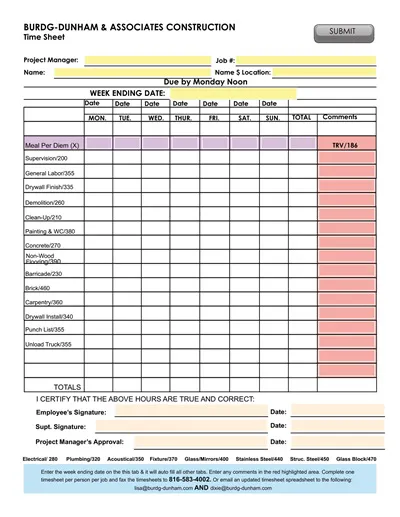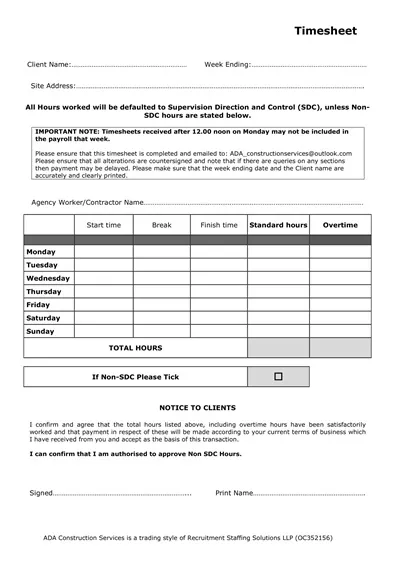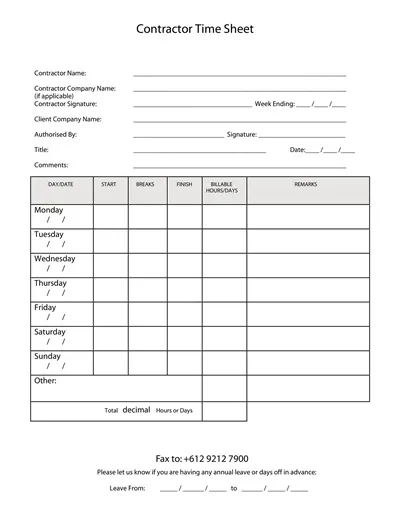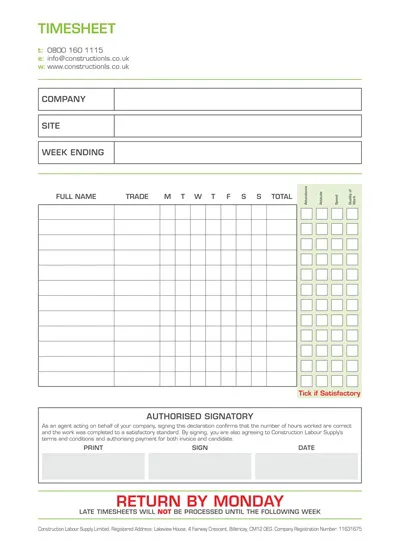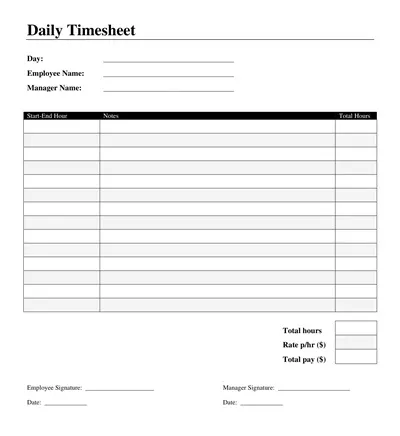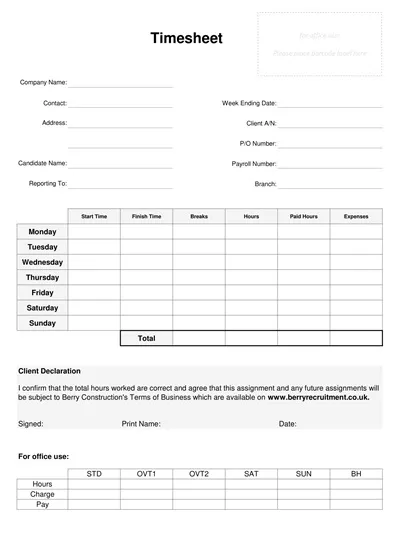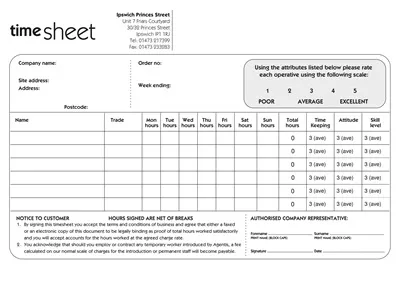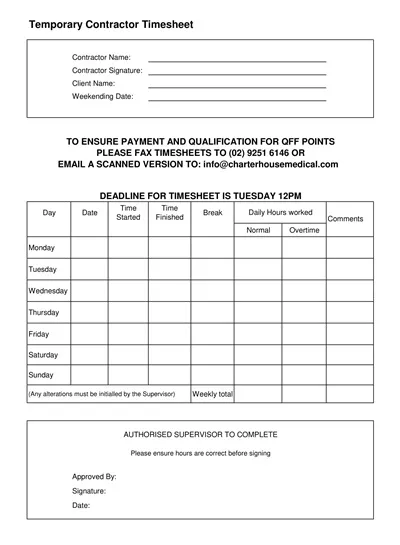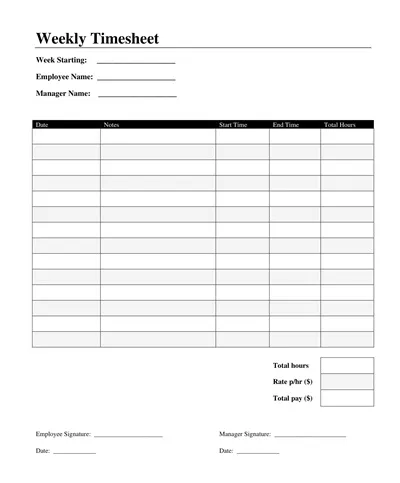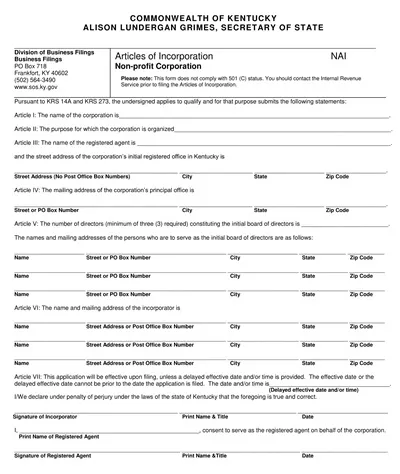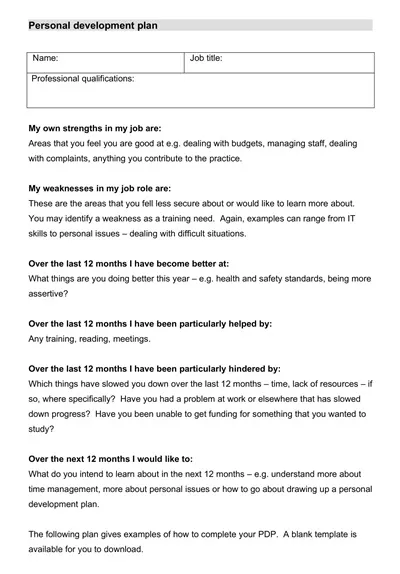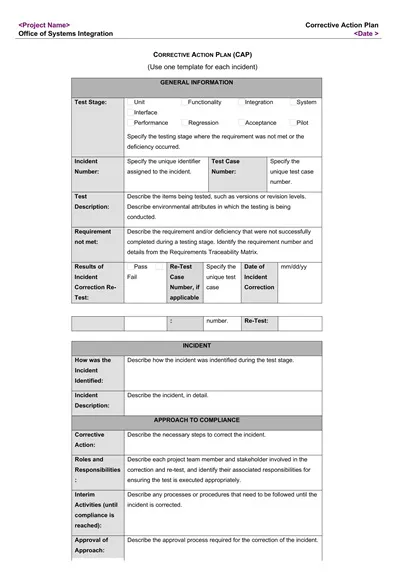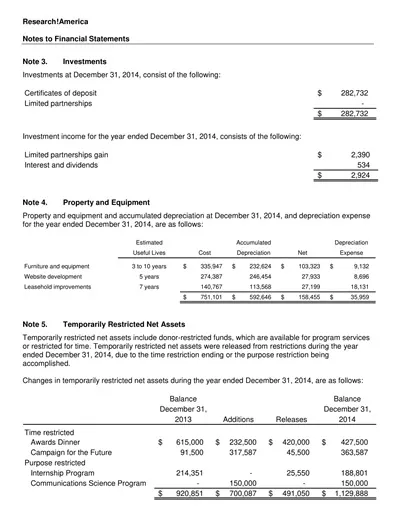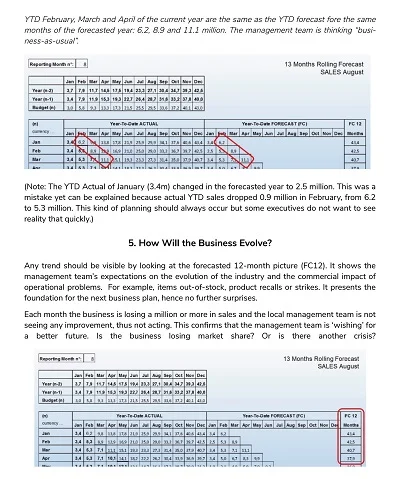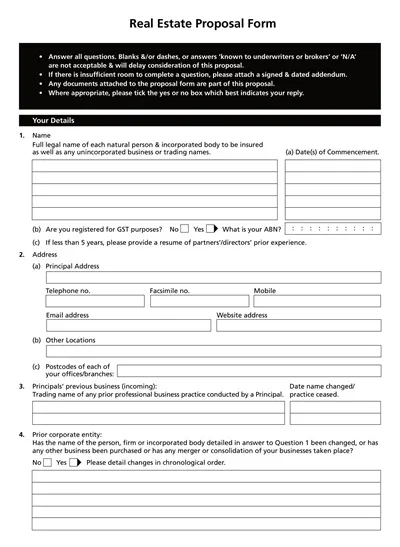A Construction Timesheet Template is a type of form employed in construction firms to document the time spent by the workers on your projects. Payroll calculations, costs, and compilation of labor laws make this document very useful in all project costing. Normally, fields covering employee names, job titles, dates, start and end time, total hours worked, and description of performed jobs are provided.
Standardizing this information helps the construction firms to minimize the inconsistency in record keeping, enhance effective management of projects, and enhance efficient resource management on all the projects. Also, using attractive layouts on its timesheets can enable the organization to identify productivity trends and plan the workforce properly.
Download Free Construction Timesheet Templates
What is a Construction Timesheet?
A construction timesheet is a construction tool or an account of a record of the organizational construction staff’s working hours and activities on a specific construction project. Through the ability to track hours worked, employers can control labor costs, predict the time within which projects will be completed, and approve the claims of employees on time spent on the project.
There are two basic types of timesheets: manual, which is printed on paper, and automated, whereby they are incorporated into computerized time recording software. That is why construction timesheets can increase transparency, help to adhere to the budget within projects and improve the overall efficiency of enterprises. This systematic approach assists in attempting to reduce mistakes with the computation of payrolls and aids in decision-making regarding employees.
Types of Construction Timesheets
There exist various construction timesheets that address the particular needs of the organization in terms of software advancement. The most common types include:
- Paper Timesheets: These traditional hard copy format forms also include those hand-completed at the workplace by workers and handed over to supervisors for signing. For occasions when they are used on a small scale, they can be relatively cheap to implement and operationalize. However, their lack of validity can lead to errors and may take longer when entering computerized systems.
- Excel-Based Timesheets: The use of spreadsheets may be Excel) is also more manageable and less challenging than other methods of digitizing the timesheet data. Excel templates provide fields and formulas that sum up the time on the computer, making them a favorite of the company seeking an online solution without programming software.
- Digital Timesheets: Self-explanatory and almost always a part of project management software or human resource tools, digital timesheets can significantly simplify the input and management of working hours. These can be used on computers, tablets, or smartphones- making them flexible and real-time, which is convenient for both the employee and the managers.
- Time-Tracking Software: Sophisticated solutions efficiently manage timesheets and offer elaborate systems that capture time. They include GPS, clock in/out, and other services: analytics that aid organizations in effectively managing labor using existing laws in countries.
The given types of timesheets also have their benefits, and the choice depends on the company’s size, budget, and technological base.
Why Do You Need a Construction Timesheet?
Construction timesheets are important in tracking workers and guaranteeing that projects will run successfully. It offers a systematic approach to timeously and effectively document the number of man-hours that employees could work, which is significant in many ways.
First, using timesheets is useful to minimize the risks of erroneous payment and non-standard calculation processes within organizing payroll. In addition, they help monitor the labor budget, one of the largest expenses on construction sites, to make more accurate decisions in the financial aspect.
Timesheets are also used in meeting legal requirements in labor practices by acting as enough evidence of the working hours that a company has taken from its employees to defend itself in court systems if at all this happens.
On a managerial level, it provides more efficient project management by signing out the productivity of work and the possibilities of the occurrence of a delay, which makes the changes prompt and the use of resources appropriate. In synthesis, the ideal timesheet system benefits from increasing reliability, accountability, and effectiveness in construction.
Key Components of a Construction Timesheet
A common construction timesheet has several essential parts that must be very well included in a construction timesheet with the intention of producing accurate records of the employees’ activities. These components are essential for capturing necessary information and streamlining the process of payroll and project management:
Employee Information
This normally consists of an employee’s name, the title of the job post, an identification number, etc. Such details assist in disentangling the workers and attributing rightful parts to their hours recorded.
Project Details
Including the Project Name or code, the location of the consultant’s work, and client details guarantees that time spent working is billed and recorded properly for the specific project.
Dates and Work Period
Designating the date and the beginning and ending hours of each work period affect the work hours to be accomplished daily. This section may provide fields for hours worked during regular working, overtime and breaks to distinguish the rates to be paid.
Task Descriptions
Writing down tasks or activities expounds on hours to offer insight into productivity and resource use by offering a context.
Approvals
Optional basic areas commonly involve fields for the signature of the provincial and district employees to substantiate the documented hours and approve the documentation for payroll purposes.
Comments or Notes
It is helpful to have an optional box for comments & notes underneath this section because it is useful if you need to write an explanation of other special events happening, for example, bad weather the next day or someone changing working hours.
Thus, including these components in the construction timesheets helps maintain a proper record-keeping system and enhances the working structure of construction assignments regarding labor management.
Tips for Using a Construction Timesheet
Optimizing a project’s construction timesheets entails applying and adopting practices over time. Here are some tips to ensure your timesheet system delivers optimal results:
- Standardize Processes: There should be uniformity in timesheets for all projects so that there will be no confusion about how they should be filled out. This method reduces differences and makes data gathering and organization more efficient and effective.
- Train Employees Thoroughly: Sufficient training is essential for the employees to complete the timesheet properly. Give employees equally clear directions on how things are supposed to be done and give recurring updates for freshers and changes in the workflow processes.
- Set Clear Deadlines: Design a clear submission of the timesheets with details of various payroll processing and subsequent project reviews on particular timelines. The Deadliness policy helps avoid abrasion between the students and the lecturers due to consistent and well-organized data collection and reports presentation time.
- Encourage Honest Reporting: Promoting the culture of reporting the actual working hours Accustom the organization culture to the reality and faithfulness of owning to the working hours. It also eliminates the chances of mistakes and fosters credibility among the working team.
- Leverage Technology: Lease, purchase, or develop software to collect, track, and analyze timesheet information electronically. This integration also doubles up in time-saving and minimizes the chances of keying in errors.
- Conduct Regular Audits: They should occasionally scrutinize the prepared timesheets to ensure they are correct besides conforming to/company rules and regulations and labor laws. Simple audits should be made more frequently to discover the differences and apply corrections if needed.
- Monitor and Adjust: By documenting and analyzing the employees’ working hours through the timesheets, it will be easier to assess production to make the right labor decisions on the best project personnel and shift organizational schedules to enhance productivity.
By adopting the tips above, construction companies can improve their timesheets’ efficiency, credibility, and practicality, helping in better project management, cost estimations, and control.
Advantages of a Construction Timesheet
A construction timesheet system has the following benefits: it will dramatically improve project results and organizational performance. Among them, the most obvious advantage is an increase in payroll accuracy; with timesheets, even employers have records of working hours, so more seldom are employees shortchanged.
It not only enhances confidence in salary disbursement and provides job satisfaction to the workers but also reduces payroll issues and controversies with ease. Furthermore, precise monitoring of possible labor expenses through timesheets makes accurate budgeting of companies possible hence improving their allocation of the available resources to their projects.
Besides, timesheets provide important information about workforce productivity and the state of a project. From this, the managers will be able to discover the schedule of occurrences to help countercheck delays or go further to make some decisions that will help keep projects on track and costs down.
Indeed, the increased level of transparency resulting from the timesheets is effective in the prevention of breaching labor laws, thus giving the companies safeguards. Additionally, the record of working hours can be helpful and turn into a working tool in billing questions to the client and for making clear overcharges.
All in all, the construction timesheets tried to produce a clear and systematic work plan so there could be more control, reduce time wastage, and manage the construction projects’ operations and finances efficiently. Little do some construction organizations appreciate the usefulness of a sound timesheet system that underpins a successful outcome of their ventures.
How to Create a Construction Timesheet Template
Designing a good construction timesheet template requires considering what aspects should be recorded to control the construction employees optimally. Here’s a detailed guide with subtopics:
1. Identify the Information Needed
The first activity is determining what information should be entered into the timesheet as crucial. This depends on the project, the specific company rules, and other bureaucratic limits on spare time activities.
2. Choose a Format
Construction timesheets can be computerized or even drawn on paper at times. Consequently, the format you decide on must be practical and convenient for employees and supervisors. Automations present in digital solutions may be an advantage, but intentions could be imposed to train employees to use the software.
3. Assure All Essential Sections
Make sure that all components discussed earlier – like the employee name, Company details, logo, the work period for the week, description of tasks performed, approval section, comments/notes, etc.
4. Incorporate Payroll Information
Certain fields of the form should capture normal working hours, overtime hours, working breaks, and any other details that could make a difference in payroll.
5. Use Color Coding
A good example of an efficient system of how color is used to distinguish one task from another or the type of work done within a given period is as follows:
6. Test and Adjust
After establishing a template of codes of ethics, conduct a pilot study to identify any areas that require calibration when practicing the solutions with the employees before using them in the entire firm.
If these steps and the earlier-discussed tips are adopted, construction contractors can develop efficient timesheet templates suited for their professional activities and provide smooth workflow patterns in labor management.


